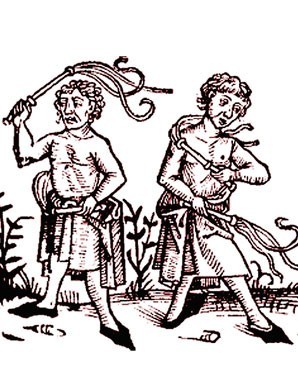‘Mortalitas magna’ – the ‘Great Death’ – the plague epidemic of 1348-9
One third of the population of Europe fell victim to the ‘Black Death’. Anyone who could fled to less densely populated areas. Processions of flagellants tried in their own way to get the plague under control.
The first outbreaks of the plague on the territory of present-day Austria occurred in Carinthia and Styria in the summer of 1348, with the whole area being affected in 1349. The plague had spread from the ports on the Crimea, especially the city of Caffa (present-day Feodosiya) on the Crimea, which had been besieged by the Tatars, who had brought the disease with them from Central Asia. Traders from Genoa spread it further by both land and sea to the whole of Europe. There were two strains of the disease: the first, the bubonic plague, was communicated directly from rats or by fleas on them and on human beings. It symptoms were festering boils on the lymph nodes of the armpits and groins. Between thirty and sixty per cent of those who contracted the disease died. The second strain was the pulmonary plague. It was communicated by droplet infection and was in most cases fatal.
That the consequences of the plague were indeed dramatic is shown by the fact that even most of the contemporary records give the number of victims as extremely high. This was indeed the case, and around one-third of the population of Europe died in the epidemic. The number of victims was especially high in areas where there was transit traffic. Other people who were particularly affected were those who nursed the sick or who lived or worked in close proximity to large numbers of other people. Those who, like Duke Albert II, were able to do so, moved away from densely populated urban areas. He fled with his Court and family to Purkersdorf just west of Vienna.
Contemporary medicine was completely helpless in the face of the plague, which was regarded as a punishment sent by God. That was also the reason why so many people tried to obtain divine forgiveness by inflicting punishment on themselves. The processions of flagellants emanating from the German-speaking parts of Europe wandered all over the continent in groups of between fifty and 450. Women were supposed to flagellate themselves only behind closed doors.
The plague epidemic of 1348-9 not only resulted in a massive decrease in the population of Europe but also had a long-term effect on the structure of settlement and the economy.















